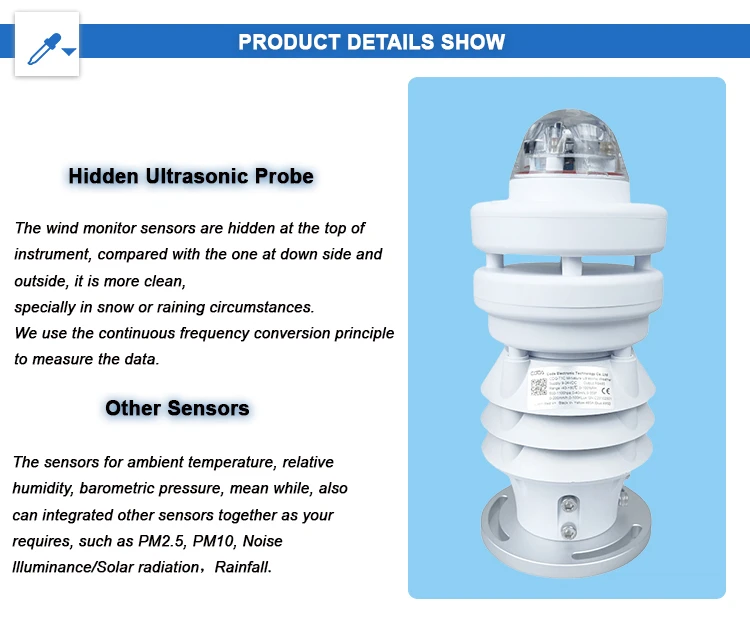What is the Ultrasonic weather station?
An ultrasonic weather station is a smart device that uses ultrasonic technology to measure weather elements. Air movement changes how fast ultrasonic waves travel. The weather station uses these waves to find out wind speed and direction.
Technicians install sensors for temperature, humidity, and air pressure. It can also sense rain. Since it has no moving parts, it is very accurate. It reacts quickly to changing weather and requires little maintenance.
This makes it a good choice for many uses. It helps with weather research and forecasts. It also helps farmers manage their crops. Plus, it supports the smooth operation of wind energy farms.
An ultrasonic weather station is a new tool for tracking the weather. It uses ultrasonic technology to measure weather conditions. Here are some key points about it:
1.weather station Working Principle
Ultrasonic sensors in the weather station send out ultrasonic waves. These waves move through the air and bounce back when they hit objects. By measuring how long it takes for the waves to return, the weather station can find out wind speed and direction.
For example, when we measure wind speed, moving air affects the ultrasonic waves. We can use this change in wave time to get wind speed data.
Some ultrasonic weather stations use special technology to measure precipitation. They can detect rain, snow, or hail. They do this by looking at how ultrasonic waves interact with the falling particles.
2.weather station Measured Parameters
Wind Speed and Direction:
Ultrasonic sensors can accurately measure the speed and direction of the wind. This is crucial for a wide range of applications, including aviation, maritime navigation, and wind energy assessment.
Temperature and Humidity:
Most ultrasonic weather stations have sensors to measure temperature and humidity. These sensors work in different ways. They use thermistors to measure temperature.
For humidity, they use capacitive or resistive sensors. This helps provide accurate data on the surrounding conditions.
Atmospheric Pressure:
People often include a barometric pressure sensor in an ultrasonic weather station to measure the atmospheric pressure. Changes in atmospheric pressure can show important weather changes. This includes the approach of a storm or a high-pressure system.
Precipitation:
Ultrasonic weather stations can detect precipitation. They measure rainfall, snowfall, or hail over time. This information is useful for hydrology, farming, and predicting floods.
3.weather station Advantages
High Accuracy:
Ultrasonic technology gives very accurate measurements of wind speed and direction. This is better than traditional mechanical anemometers. Ultrasonic sensors have no moving parts. This reduces wear and tear and makes the weather station more reliable over time.
Fast Response Time:
Ultrasonic sensors can quickly react to changes in the weather. This is important for tasks that need real-time data, like monitoring severe weather and early warning systems.
Low Maintenance:
Ultrasonic weather stations have no moving parts. This means they need less maintenance than regular weather stations. Because of this, they cost less to own. This makes them great for remote or hard-to-reach areas.
Compact Design:
Ultrasonic weather stations are smaller than regular weather stations. This size makes them easier to install in many locations, such as rooftops, towers, and mobile platforms.
4.Ultrasonic weather station Applications
Meteorology:
Ultrasonic weather stations are often used in weather research and forecasting. They gather data on weather conditions accurately. This data helps make weather models and forecasts better.
Renewable Energy:
In the wind energy industry, ultrasonic weather stations are used to measure wind speed and direction at potential wind farm sites. We use this data to assess the wind resource and to optimize the design and operation of wind turbines.
Agriculture:
Ultrasonic weather stations give important information about weather for farmers. They help farmers decide on irrigation, fertilization, and pest control. Farmers can also use them to see how weather affects crop growth and yield.
Environmental Monitoring:
People use ultrasonic weather stations to watch the environment. These stations measure air quality, temperature, humidity, and more. We use this data to understand how human activities affect the environment. It helps us make plans to protect the environment.
In summary, an ultrasonic weather station is a powerful and flexible tool for measuring weather. It offers high accuracy and a quick response time. It also requires low maintenance and has a compact design. This makes it useful in many fields, such as meteorology, renewable energy, agriculture, and environmental monitoring.
